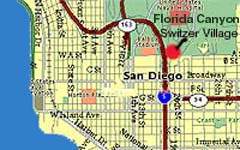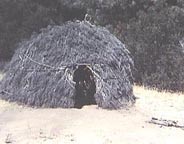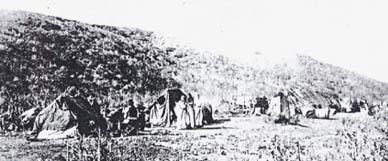|
He reported established Kumeyaay villages at the mouth of the Tijuana,
Sweetwater and Chollas Rivers. Then, as now, the Kumeyaay tribal
band structure lends itself to many human scale patterns of settlement.
Often times these villages or rancherias or shiimull are structured
to maintain harmony and balance.Water is life in San Diego. Before
there were Euro-American settlements of the: Royal Presidio, Mission
San Diego de Alcala, Old Town, Newtown, Mission Valley, National
City or Balboa Park, Kumeyaay tribal people occupied every Valley
and stream. There were over twenty Kumeyaay rancherias/villages
within sight of the Presidio. Just South of the Presidio or what
became Newtown is Indian Point. Even now, in the new millennium,
is not unusual for local tribal people to be able to call upon oral
custom and tradition and recognize direct ancestors and specific
village locations in this San Diego area of over 800 years. Indian
Point, we now list historically, as the 'property' of Middletown
and Newtown. These areas were part of the Pueblo land purchased
from the City after 1850 for real-estate investments. Tribal people
from the Kumeyaay villages bordering Middletown and Newtown provided
a majority of the labor though-out the development then and into
modern times. This pattern was repeated in other California cities
along the coastal areas.
| From 1860 to 1890 a large Kumeyaay village is
acknowledged to have occupied the mesas and canyons east of
Russ School, near 18th and 'B' streets. Also, one of the best
documented rancherias is the Switzer Canyon, or now Florida
Canyon Kumeyaay band village. In the area where 19th and 20th
streets intersect 'A' and 'B' streets signs of the long occupation
are still found. Manuel Hatam was the well recognized leader
of the Tribal people living on this Balboa Park location. |
 |
 |
For thousands and thousands of years Kumeyaay
people lived all over this coastal area; Florida Canyon, Indian
Point, Chollas Creek. The significance and prominance of these
Kummeyaay villages is often dismissed, then and now, due to
cultural perceptions of acceptable habitat. Most notably is
the sharp contrast of 'gingerbread' Victorian style to the traditional
summer habitat of willow and other natural materials in the
Kumeyaay Eawa. From about 1860, possibly earlier, the Capitan
or spokesman of this Florida Canyon Kumeyaay village is Manuel
Hatam. |
MORE >>
|


